Vol. 41, #2, Summer 2023
Two Controversial Rubies Hit The Auction Markets, Gemstone News, Diamond News
- Home
- Newsletter
- Vol. 41, #2, Summer 2023
Two Controversial Rubies Hit The Auction Markets, Gemstone News, Diamond News
25.59 Sunrise Burmese Ruby
The 25.59 Sunrise Burmese ruby sold for a world record US$30.42 million at Sotheby’s Geneva in May 2015. That totaled over $1.1 million per carat. The Sunrise Ruby is 'stoplight vivid red' color and has eye visible inclusions (making it moderately included, or MI). Many argue a Burma ruby should be Lightly Included (LI) to command this price. It was reauctioned on May 10, 2023 at Christie's in Geneva as a part of the $150 million Heidi Horton estate. The entire Horton collection sold for $201 million, beating the 2011 sale of Elizabeth Taylor's $137 million collection.
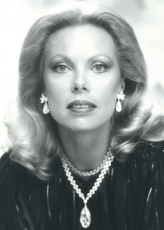
Surprisingly, the Burma ruby only sold for slightly over $14.6 million, or about $570,000 per carat. This is less than one half of the 2015 sale. Does that mean the Burma ruby market collapsed? No, not really.
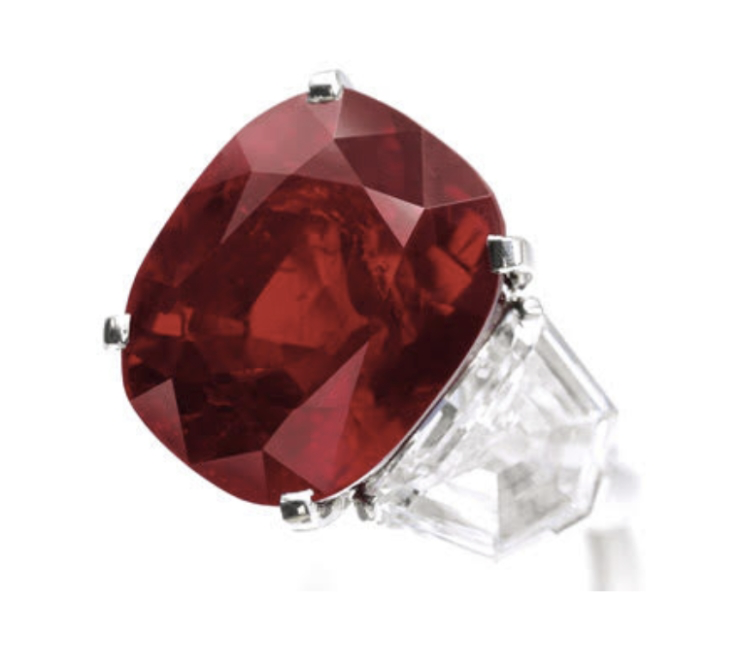
25.59 Sunrise Ruby
The backstory is pretty interesting. Heidi married into the German Horton Department store family when she was 19 and Helmut was 51. When he died in 1977, she was left with $1 billion. She was an avid art and jewelry collector, and later died in 2022 worth $3 billion.
Many Jewish groups didn't want the estate's auction to proceed because Helmut Horton had a bad reputation for having bought many distressed Jewish businesses during the Nazi era. The Simon Wiesenthal Center and the Holocaust Educational Trust publicly opposed the sale. Christie's decided to offer significant contributions from the Horton sale to organizations advancing Holocaust education. We wonder how this affected the sale? Another factor may be how the stone was hammered on social media. Some FB groups deeply criticized this stone, and we wonder if negative social media attention impacted the price? After all, the Burma ruby market is not down. In fact, prices are skyrocketing. The Sunrise ruby had Gubelin and SSEF lab documents stating the stone is pigeon blood. Regretfully, the stone didn't have an AGL full Prestige Report with color/tone and clarity. Perhaps this was a factor as well. Are auction results the true price of gemstones and colored diamonds? We notice many dealers raise their prices when gem auction records are reached. When two wealthy people who are both used to winning are both vying for the same stone, they can bid top stones to unreasonable heights. Maybe that is what happened in 2015? Is this the real market for gems? Probably not.
Let's look at the other one.
55.22 Mozambique Ruby
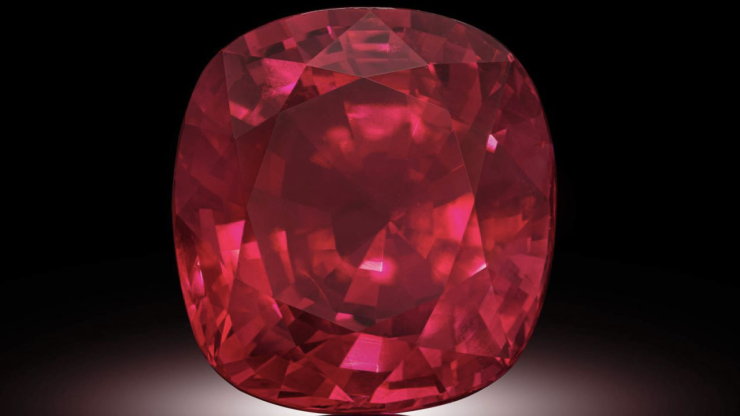
The 55.22 unheated Mozambique ruby was expected to surpass the old 2015 Sunrise Ruby's record price of $30.42 million in the total sales amount for a ruby at auction prices. It did accomplish this.
The gem was was discovered from FURA’s ruby mine in Mozambique in July of 2022. Originally, the gemstone weighed 101 carats and was subsequently named Estrela de FURA (Star of FURA in Portuguese). At that time, the stone was claimed to be worth $100 million. After cutting, the 55.22 stone was valued at $30 million or slightly over $540,000 per carat. It sold for $34.8 million or $630,000 per carat on June 8, 2023 at Sotheby's.
This seems an excellent price considering the photos that circulated on social media. The stone was smashed on some social media sites because of its color/tone, clarity, and cutting. Many posts included photos of the stone contending the stone was too purple or not very red. Below are two screen shots from Sotheby's Instagram. Others say the stone looks like heated red/black Thai ruby or bad garnet. See the SSEF stone image from the original cert at bottom.
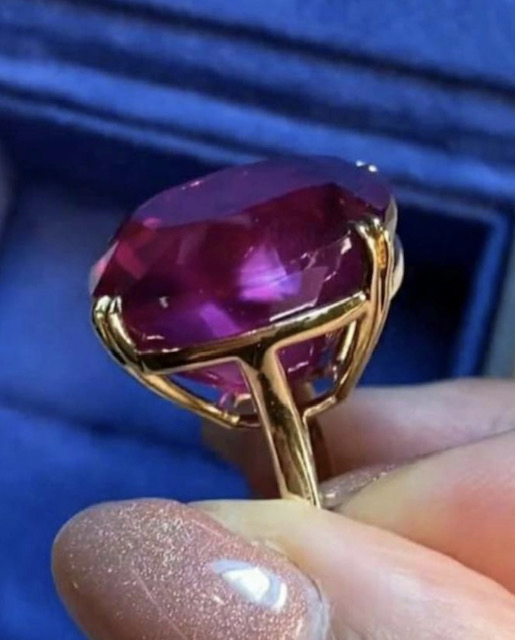 Courtesy; Sotheby's Instagram |
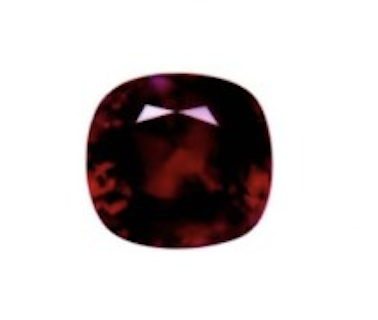
Lab Reports
Another interesting facet of this story is the lab reports. The premier lab report is the AGL Prestige Gemstone Report. (See below). It calls the stone Classic Mozambique red no heat. Why didn't FURA ask the lab for a full grading report? It would have easily solved the most pressing issues about the stone, such as color/tone, clarity and cutting. We find it disturbing how many sellers do not obtain this additional information, because the increased cost of a full grading AGL Prestige Report is minor. Perhaps FURA or Sotheby's did not want to provide critical information for some reason. Disturbing.
The gem also was bizarrely graded by 4 more labs. Gubelin also called the color red. SSEF called the stone red of strong saturation. GRS called the stone pigeon blood. Finally, Bellerophon (French Lab) called the stone pigeon blood. What do all these color differences mean? Do labs see the color of this stone differently? First, AGL never uses the misused word pigeon blood to describe ruby. Kudos to AGL for this policy. Interestingly, Gubelin still uses the word pigeon blood but did not call the Mozambique pigeon blood color. Same with SSEF. Some labs use and misuse the term with almost any ruby, making it essentially meaningless. Bellerophon and GRS could be prime examples of this unconscionable policy. So was the stone vivid red or not? Sure is hard to know from these various lab reports or photographs. Without a full AGL grading report of 2.5 color, sadly, we will never know for sure. It definitely means international standards and harmonization are critical for the labs to be more consistent in their color grade calls. This would help protect gem buying consumers. We are not holding our breath.
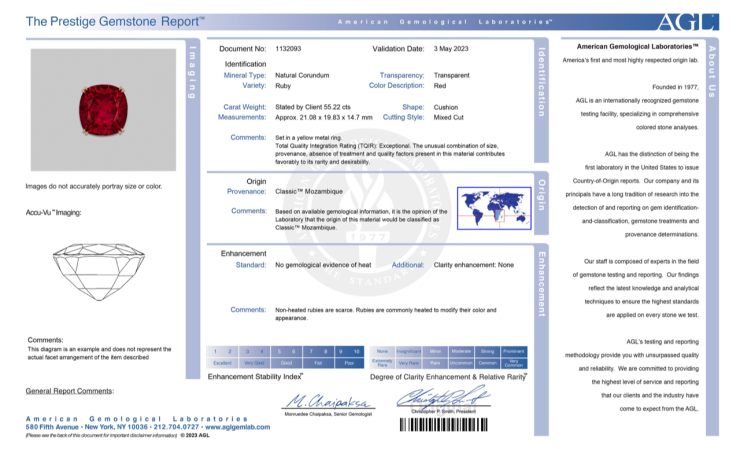
Mysterious Sale
What is really interesting about the sale is another stone, The Eternal Pink, sold for the exact same total price. The diamond is a 10.57 fancy purplish-pink. Both sold for exactly $34.8 million! According to ArtNet News, the buyer was a private collector in the Middle East. Supposedly, both lots were guaranteed to sell and backed by irrevocable cash bids.
These auctions are often not at all like they are portrayed in the movies, where the bidding is slow and suspenseful. The stone sold amazingly quick after a few telephone bids. Almost like the deal was already done. Some dealers believe the entire auction of the Mozambique was a set up. It was bought back by FURA to prove the value of these Mozambique rubies. The thought is these stones are tired of being seen as "second class" citizens and FURA wanted to make a serious public statement. Who knows really? Of course, according to Sotheby's Buyer premium, the sale must include a 13.9% fee for the auction house. This is about $5 million. Assume the seller ended with south of $30 million.
Trick Photography?
Before bidding on any stone on any auction, we recommend you put your eyes on the rock. This is a perfect example of a stone you cannot bid on based solely upon auction house photography. The gem looks so different in many shots. Before the internet, it was common knowledge the auction houses "juiced" the photographs of the gems they were selling. Today, with Photoshop and graphic designers, who knows what they are doing? The only true way to know what you are buying is to go to the presale viewings.
Marketing
You have to hand it to FURA. This was the best marketing of a gemstone we have ever seen. They and Sotheby's produced a ton of videos and stories that were disseminated through the traditional media and social media. Well done. The negative social media comments didn't seem to impact this sale.
Summary
The 55.22 ruby has caused a war between the Burma aficionados and the Mozambique ruby sellers. The gem world has always revered the Burma goods over any other source, for at least 800 years. Mozambique is the new kid on the block with only about 15 years since discovery. It often takes decades or longer for a stone to become accepted in the gem world. Kashmir sapphire is a prime example. As a general rule, Mozambique rubies sell for a 50-75% discount to comparable Burma rubies.
Let's take a look at the auction numbers and see if they have a story to tell. Please remember, when a gem mine is first discovered, the biggest gems are often found first and dwindle over time. For example, we have never seen a 55 carat gem red Burma ruby. The Mozambique Ruby sold for more than any Burma ruby because of its size. What is more important is the price per carat.
We postulated the 25.59 Sunrise ruby would sell for more 8 years later, because this often happens. Instead on May 10, 2023, it sold for only $14.6 million or $570,000 per carat, down from $1.1 million per carat in 2015. The 55.22 Mozambique sold for $630,000 per carat. Perhaps we should consider the 2015 Sunrise Ruby sale the exception rather than the rule? The unheated Burma ruby market has dramatically risen since 2015. Also in 2015, the 15.04 Crimson flame sold for $1.2 million per carat, the present record for Ruby price per carat. Closer in time, the 11.20 Dupont Ruby sold for $880,000 per carat in 2019. Recently, a 6.41 Burma ruby was purchased for $436,000 per cart. Mozambique rubies recent stats? At Christie's, May 2023, they sold the 54.95 "The Star of Africa" for about $3 million or $54,000 per carat. Not a good track record so far.
We can make the argument this 55.22 Mozambique ruby is fairly priced because it is 3X as large as the Crimson Flame Ruby and was sold for about 1/2 the per carat price, which is an acceptable discount to what the selling price would be if it were true stoplight Burma red. Perhaps $630,000 per carat is the price of this very large gem red Mozambique ruby. Imagine what a 50 carat plus vivid red Burma would sell for? At least triple the per carat probably.
Finally, an unscientific survey on the Facebook Group Scamologist polled its members, on whether "The entire auction was a marketing and promotional stunt from the beginning, to increase the value of Mozambique rubies?" The majority (56%) of gem dealers agreed. Only 1% thought the auction seemed legit.
Charges of auction house insider trading and dealer favoritism are often rumored in the gem trade. Perhaps it's finally time to look into the auction house business dealings too, like in crypto. The gem buying public needs to know the auction houses are straight. The sale of the 55.22 raises a lot of questions.
Gemstone collectors tend to be white diamond collector/investors or colored gemstone collector/investors. This is an interesting primer on the two different gems. ED
As we approach the summer of 2023, investors are constantly on the lookout for new opportunities to grow their wealth and diversify their portfolios. One fascinating area that deserves your attention is the world of precious gemstones, particularly rubies and diamonds.
In this article, we will compare the benefits and drawbacks of investing in these two captivating gems. We’ll be presenting vital insights to help you make an informed decision about whether or not rubies or diamonds should become a part of your investment strategy in 2023.
The Pros and Cons of Investing in Rubies
When considering investing in precious stones, it’s important to weigh the pros and cons. For example, rubies have certain benefits and downsides that you should take into account.
Let’s explore these pros and cons so you can make an informed decision.
Pro #1 – An advantage of rubies is their rarity. This means they often hold their value better than other gemstones-. Moreover, their vivid color makes them desirable, especially if you’re planning to buy exquisite ruby rings for that special someone.
Con #1 – High Expense: However, with rarity comes higher prices. If we consider the cost associated with rubies, they can be more expensive than other gems. This might deter casual investors or those on a budget.
Pro #2 – Durable Investment: Another pro is that rubies are a durable investment. They rank as one of the hardest stones on the Mohs scale. They sport a 9, making the ruby a durable stone! This makes them ideal for everyday wear in jewelry pieces.
Con #2 – Buying Quality Require Expertise: On the flip side, it’s important to understand that buying quality rubies requires expertise. Identifying factors like color saturation and flaws can be challenging without prior knowledge or experience in the field.
Pro #3 – Diverse Portfolio: Finally, investing in rubies allows you to diversify your portfolio beyond traditional assets like stocks and bonds. Just bear in mind that gemstone prices can be volatile, so they may not always be a good investment.
The Pros and Cons of Investing in Diamonds
Similar to rubies, investing in diamonds comes with its own set of advantages and disadvantages. By understanding these factors, you can decide if adding diamonds to your investment portfolio is the right choice for you. Should you invest in diamonds instead? Let’s see.
Pro #1 – Global Recognition: One major pro of investing in diamonds is their global recognition. Diamonds are highly sought-after gemstones worldwide, making them relatively easy to trade and sell compared to other precious stones.
Con #1 – Pricing System: However, a potential downside lies in the diamond pricing system. Unlike gold or silver, there isn’t a universally accepted standard or index for diamond prices. This means that determining the accurate value and price of a diamond can be challenging.
Pro #2 – Symbolic Value: Another advantage is that diamonds hold symbolic value across cultures. For instance, they are often associated with love and commitment, which contributes to their popularity in engagement rings and wedding bands.
Con #2 – Ethical Concerns: Conversely, ethical concerns have become more prevalent recently due to issues like conflict diamonds and environmental impacts related to mining. As an investor, it’s essential to research the origin of your diamonds and ensure they are ethically sourced.
Pro #3 – Diverse Portfolio: Lastly, similar to rubies, investing in diamonds allows for diversification within your investment portfolio. Just keep in mind that, like all investments, the value of diamonds may fluctuate over time due to market demand.
In Conclusion: What’s the Better Option?
Both rubies and diamonds offer remarkable opportunities for investors seeking to diversify their portfolios with precious gems. The key is to carefully consider the pros and cons we’ve laid out in this article and take the time to research and understand each gemstone’s characteristics.
As you make your decision, seek advice from industry experts or gemologists who can help you identify high-quality stones that fit your budget and align with your investment goals.
If you are considering collecting gemstones, this is a good basic introduction. ED
When it comes to gemstones, it's not only size that matters. Many factors determine the value of gems.
Are you a collector looking to bolster your gemstone collection? With the tips below, you'll learn how to tell the difference between low-quality stones and valuable gemstones.
Rarity
Rarity determinants include the availability of the material, the size, and the clarity. Smaller, rarer stones tend to fetch higher prices when compared with larger, more common specimens.
Furthermore, the origin of gemstone is also highly relevant. Valuable gems come from exotic and hard-to-access locales and are seen as more prestigious when compared with others. So, rarity should always be considered when appraising gemstones. A qualified gemologist should be consulted to get the current market value of a collectible gemstone.
Color
Another key element in evaluating the value is the color of the stone. Gemstones with pure, saturated red, blue, pink, and green hues typically fetch the highest prices. The more intense and even the color, the more valuable the gemstone will be.
Colorless gemstones with crystal-clear transparency are valuable, mainly when emitting a solid sparkle. Though considered pretty, gemstones displaying soft pastel tones lack the vibrancy that collectors look for when evaluating the value of a gemstone.
Clarity
The number, size, and location of inclusions in the gem determines clarity. It can affect the beauty, durability, and value of the gem. It can range from flawless or internally flawless to heavily included.
The fewer and smaller the inclusions, the higher the quality and greater the stone's value. Gemstones with eye-clean to very slightly included clarity are often considered valuable, especially if there is an intense saturation of color.
Size and Shape
Larger stones are often more valuable, as they are rare and unique. Shapes also affect a gemstone's value, as more symmetrical and difficult-to-cut shapes are desirable.
Shape and size can even interact to make certain stones more valuable. For example, a round and large gemstone may be more valuable than a similarly sized gemstone in an irregular shape.
Enhancement Techniques
Enhancement techniques are used to improve the appearance or value of a gemstone. These techniques alter, improve or mask a gemstone's desired look or quality. Examples of gemstone enhancement techniques include applying heat, using dyes, oiling, irradiation, or even glass and plastic treatments.
Collectors need to be aware of such techniques as appraising gemstone values depending on the stone's quality, clarity, and nature. They should become familiar with gemological terms. As these can help to identify enhanced gemstones, as well as assess their value.
Research reputable and experienced appraisers to evaluate different stones. They should also become familiar with the techniques and methods involved in gemstone enhancement. It's also vital for them to know how to spot fake ones.
For example, the stone amethyst is a strong reddish purple or purple with no visible color zoning. After enhancements, there may be some color changes.
Check These Factors in Evaluating the Gemstone Value
The gemstone value depends on many complex factors. Collectors should use this guide as a starting point to understand the evaluation process. Gemologists and specialists are also invaluable resources in determining the true worth of a gemstone.
You should use all these resources to increase your knowledge and make the right decisions.
We wish this seemingly impossible project good luck. Think mining in Siberia or Switzerland as examples of the hardships involved. But the world sure needs some more Kashmir sapphires! ED
The Jammu and Kashmir mining department has announced plans to extensively and scientifically explore the world-famous sapphire found in the Paddar Valley of the Kishtwar district. According to officials, the sapphire from the valley is renowned around the world for its unique peacock blue tint.
On May 17, 2013, a 19.88 carat cushion-shaped Paddar sapphire known as the Star of Kashmir broke all auction records when it sold for $3,483,017 (almost 20 crore). Located at an altitude of 4,742 metres above sea level, a 116-km stretch in the valley is estimated to have a reserve of sapphire worth Rs 2,700 crore.
To begin the project, Amit Sharma, the mining secretary of Jammu and Kashmir, held a meeting on Tuesday to discuss strategies and tactics for sapphire exploration in the Padder region of the state. “The MCEL is going to explore the world-famous sapphire from the padder and the government is spending a good amount of money 50-60 crore on this project,” Sharma said. “The extraction of the sapphire, which will benefit the entire nation, is a huge and important event for Kashmir.”
In order to ensure the smooth completion of this project before the end of the working season, the government plans to establish various steering committees at the policy-level and the execution level. “MECL will share detailed timelines, and the government will review their adherence on a weekly basis,” Sharma revealed.
The Geological Survey of India (GSI) had previously prepared a PowerPoint presentation on the famous sapphire and ruby-like precious gems in several audits before two or three years ago in the khan area of the Padder. The crew is deliberately looking for a method to explore the famed sapphire.
Extraction of sapphires from Paddar began in 1885 and they received legendary status in the jewelery business. OP Bhagat, director of geology and mining, Arun Kishore Kotwal, director of the geological survey of India’s J&K branch, Ajay Kumar, general manager of mineral exploration and consultancy limited (MECL), P Ravindran, and J&K Minerals Limited MD, Vikram K Gupta, were present at the meeting in addition to mining experts.
The mining department’s higher-ups have also advised deputy commissioner Devansh Yadav to fully support the working group headed by the geology and mining director for the upcoming exploration of the mines using National Minerals Exploration Trust (NMET) funding in a manner that is based on science.
According to reports, the project is expected to be completed before the end of the working season, and the extracted sapphire will benefit the entire nation. The officials have high hopes for the project, which is expected to create a significant positive impact on the country’s economy.
This project is expected to not only benefit the mining industry but also create job opportunities for the locals. The officials have revealed that the government is spending a good amount of money on this project, which is a huge and important event for Kashmir.
The officials have high hopes for the project, which is expected to be completed before the end of the working season.
The Gemological Institute of America (GIA) has responded swiftly to industry criticism over the decision to issue digital grading reports, confirming a return to paper certification.
In June of 2022 the GIA confirmed a move towards a ‘paperless’ operation.
In recent weeks members of the diamond trade have expressed their displeasure to the new system, with customers accustomed to paper certificates reportedly unhappy, while others said they were concerned that the process was susceptible to abuse.
On April 7 the GIA responded to the feedback, announcing a return to printed certificate April 9 onwards.
Customers who received a digital report over the past few months can request a paper version at no cost.
“We did not adequately anticipate the challenges of adopting the digital-only GIA Diamond Dossier report,” said GIA senior vice president Pritesh Patel.
“GIA will continue to provide the printed reports that enhance consumer trust, while working to develop robust, secure, and compelling digital versions of all our reports.”
New GIA, De Beers partnership
De Beers has signed the GIA to its Tracr platform, enabling the laboratory to issue enhanced grading reports for polished diamonds documented by the blockchain service.
The stated aim of the collaboration is to further improve consumer confidence in the ‘ethical’ origins of ‘natural’ diamonds.
“As the issue of diamond provenance rapidly increases in importance for stakeholders across the diamond value chain, having immutable data about a diamond’s journey from the source on grading reports is a major step forward and will underpin consumer confidence,” said De Beers acting vice president Ryan Perry.
Patel added that solidifying public confidence in diamond products was at the core of the GIA’s ‘consumer-protection mission’.